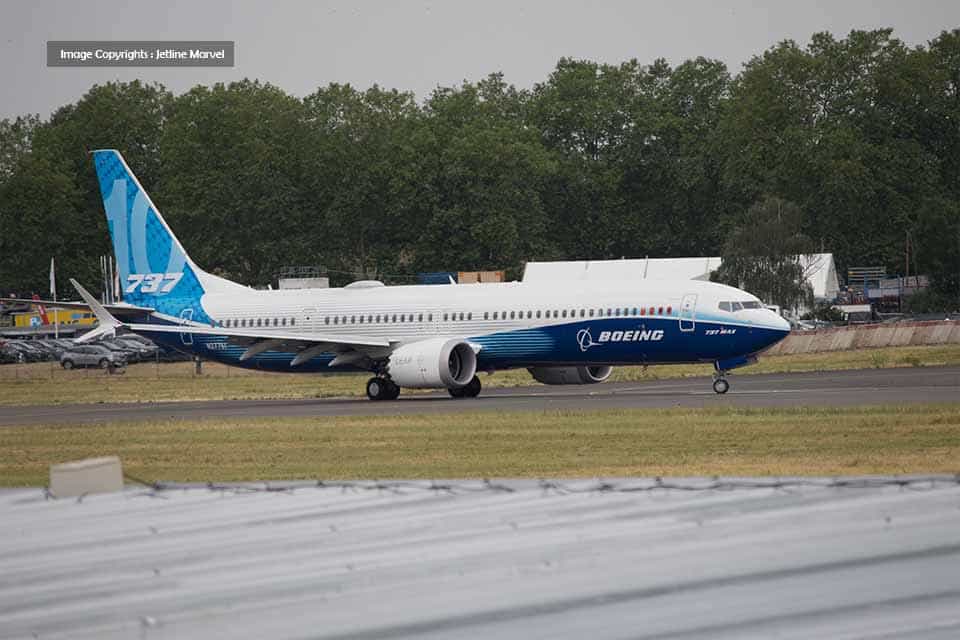Aerospace
Boeing Begins Final Assembly of First 737 MAX

RENTON, Wash., Sept. 15, 2015 – Boeing [NYSE: BA] employees in Renton, Wash., have started final assembly on schedule of the first 737 MAX 8, the first member of Boeing’s new, more efficient single-aisle family.
“We continue to meet our plan on the 737 MAX program thanks to the dedication of our employee team and our suppliers,” said Keith Leverkuhn, vice president and general manager, 737 MAX program, Boeing Commercial Airplanes. “We have a lot more work still ahead of us but we’re very pleased with our progress to date.”
After the first fuselage arrived on Aug. 21 from Spirit Aerosystems in Wichita, Kan, mechanics began installing flight systems and insulation blankets.
“It’s an honor. There is only one crew that gets to be that first crew that builds that airplane. I’m really excited,” said Sean Christian, 737 MAX Electrical team lead.
Crews next moved the fuselage to the wing-to-body join position on the new production line where the first MAXs will be built. Mechanics then attached the wings to the body of the airplane.
The wings feature Boeing’s new Advanced Technology winglets. Designed exclusively for the 737 MAX, they will give customers up to 1.8 percent additional fuel-efficiency improvement over today’s inline winglet designs.
“Seeing the new winglet design we validated in the wind tunnel years ago now on the first new airplane is incredible,” said Leverkuhn. “It’s just one of the features that differentiate the 737 MAX and make it an amazingly fuel-efficient machine.”
Boeing will build the first 737 MAXs exclusively on the new production line in the Renton factory. Once mechanics prove out the production process, the team will extend MAX production to the other two final assembly lines in Renton.
“The opening of a brand new production line in Renton increases our flexibility and capacity, allowing this incredible team to continue to meet our customers’ need for the world’s most reliable single-aisle airplanes, well into the future,” said Scott Campbell, vice president and general manager, 737 program and Renton site leader, Boeing Commercial Airplanes.
The 737 MAX team remains on track to roll out the first completed 737 MAX by the end of the year and fly it in early 2016. Launch customer Southwest Airlines is scheduled to take delivery of the first 737 MAX in the third quarter of 2017. In total, the 737 MAX family has 2,869 orders from 58 customers worldwide.
Liked It ..!?
Share with your friends and family.

Aerospace
Boeing Transfers Rocket Stage to NASA, Paving Way for Human Moon Mission

Boeing has achieved a significant milestone by providing NASA with the second core stage of the Space Launch System (SLS) rocket.
This crucial component, crafted at NASA’s Michoud Assembly Facility (MAF), is set to propel the Artemis II crew into lunar orbit, marking humanity’s return to deep space after a 50-year hiatus.
The monumental Boeing-built rocket stage, the largest element of the Artemis II mission, will embark on a journey aboard the Pegasus barge, traveling 900 miles to NASA’s Kennedy Space Center.
Comparison of two legendary aircraft B777x vs B747 aircraft:Click here
Upon arrival, it will be meticulously integrated with other essential Artemis II components, including the upper stage, solid rocket boosters, and NASA’s Orion spacecraft within the iconic Vehicle Assembly Building. This intricate integration process is a vital step toward the eagerly anticipated Artemis II launch, slated for 2025.
“Boeing-built products helped land humankind on the moon in 1969, and we’re proud to continue that legacy through the Artemis generation,” remarked Dave Dutcher, vice president and program manager for Boeing’s SLS program. “Together, with NASA and our industry partners and suppliers, we are building the world’s most capable rocket and paving the way to deep space through America’s rocket factory in New Orleans.”
NASA, Lockheed Martin Reveal X-59 Quiet Supersonic Aircraft:Click here
The delivery of Core Stage 2 marks a significant achievement in the evolution of the SLS rocket. Towering over 200 feet and powered by four RS-25 engines, this core stage, coupled with two solid-fueled booster rockets, will generate a staggering 8.8 million pounds of thrust. This immense power is crucial to launching Artemis II and future missions into the vast expanse of space.
The SLS rocket stands unparalleled in its capability to transport both crew and substantial cargo to the moon and beyond in a single launch. Its extraordinary capacity will facilitate the delivery of human-rated spacecraft, habitats, and scientific missions to destinations including the moon and Mars, ushering in a new era of space exploration.
-

 Travel1 week ago
Travel1 week agoAir India to Expand US Operations with Three New Routes After a Decade
-

 Travel2 weeks ago
Travel2 weeks agoWhy We Should Avoid These Stamps in a Passport
-

 Airlines1 month ago
Airlines1 month agoInvestigations Reveal Fake Chinese Titanium in Boeing and Airbus Jets
-

 Tech4 weeks ago
Tech4 weeks agoChina’s CATL Plans 1,800-Mile Electric Plane Launch by 2027
-

 Airport3 days ago
Airport3 days agoTop 10 Largest Airports in the World by Size
-

 Aerospace4 weeks ago
Aerospace4 weeks agoChina’s Fighter Jets Turn Wings into Autonomous Drones
-

 Airlines4 days ago
Airlines4 days agoAir India Rolls Out A350s for Delhi-New York JFK and Newark Routes
-

 Defence3 weeks ago
Defence3 weeks agoBoeing Enhances Chinook with New Engines and Block II Upgrades at $96 Million







